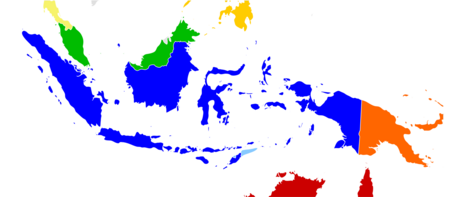Social:Malaysian Malay
| Malaysian Malay | |
|---|---|
| Bahasa Melayu Malaysia بهاس ملايو مليسيا | |
| Standard Malay Bahasa Melayu Standard بهاس ملايو ستندرد | |
| Pronunciation | Template:IPA-ms |
| Native to | Malaysia, Singapore |
| Speakers | Native: Few (2022)e25 L2: Spoken by the vast majority of those in Malaysia, although most learn a local Malay dialect or another native language first. |
Austronesian
| |
Early forms | |
| Latin (Rumi) Arabic (Jawi)[3] Malaysian Braille | |
| Manually Coded Malay Malaysian Sign Language | |
| Official status | |
Official language in |
|
| Regulated by | Dewan Bahasa dan Pustaka (Malaysian Institute of Language and Literature) Dewan Bahasa dan Pustaka Brunei (Brunei Language and Literature Bureau)[4] Majlis Bahasa Melayu Singapura (Singapore Malay Language Council)[5] |
| Language codes | |
| ISO 639-3 | zsm |
| Glottolog | stan1306[6] |
 Countries where Malaysian Malay is spoken:
Malaysia
Singapore and Brunei, where Standard Malay is an official language | |
File:WIKITONGUES- Zairul speaking Malay.webm
Malaysian Malay (Malay: Bahasa Melayu Malaysia), also known as Standard Malay (Bahasa Melayu standard), Bahasa Malaysia (lit. Malaysian language), or simply Malay, is a standardized form of the Malay language used in Malaysia and also used in Brunei and Singapore (as opposed to the variety used in Indonesia, which is referred to as the "Indonesian" language). Malaysian Malay is standardized from the Johore-Riau dialect of Malay. It is spoken by much of the Malaysian population, although most learn a vernacular form of Malay or another native language first.[7] Malay is a compulsory subject in primary and secondary schools.[8]
Status
In Malaysia
Article 152 of the Federation designates "Malay" (Bahasa Melayu) as the official language,[9] but the term bahasa Malaysia (lit. Malaysian Language) is used in official contexts from time to time.[10] The use of the latter term can be politically contentious; in 1999 the Dewan Bahasa dan Pustaka rejected the publication of some short stories as the preface to the publication used the term bahasa Malaysia instead of bahasa Melayu.[11] Between 1986 and 2007, the term bahasa Malaysia was replaced by "bahasa Melayu". In 2007, to recognize that Malaysia is composed of many ethnic groups (and not only the ethnic Malays), the term bahasa Malaysia became the government's preferred designation for the national language.[10][12][13][14] However, both terms remain in use, as the terms Malay and bahasa Melayu are still very relevant or correct according Dewan Bahasa dan Pustaka and is used in Malaysian education.[15][16] The language is also referred to as BM.
In Brunei and Singapore
The national standard variety of Malay employed in Brunei largely follows the Malaysian standard; the main differences being minor variation in pronunciation and some lexical influence from Brunei Malay, the local non-standard variety of Malay.[17]:72 In Singapore, the Malaysian standard form of Malay is largely followed, although with little differences in vocabulary, and pronunciation is similar to Indonesian language rather than the standard Johor-Riau pronunciation that is usually used in Standard Malay.[17]:206
Writing system

The Latin alphabet, known in Malay as Rumi (Roman alphabets), is prescribed by law as the official script of Malaysian Malay, and the Arabic alphabet called Jawi (or Malay script) is not legally prescribed for that purpose. Rumi is official while efforts are currently being undertaken to preserve the Jawi script and to revive its use in Malaysia.[18][19][20] The Latin alphabet, however, is still the most commonly used script in Malaysia, both for official and informal purposes.
Borrowed words
The Malaysian language has most of its borrowings absorbed from Sanskrit, Tamil, Hindustani, Arabic, Persian, Portuguese, Dutch, Sinitic languages, and more recently, English (in particular many scientific and technological terms). Modern Malaysian Malay has also been influenced lexically by the Indonesian variety, largely through the popularity of Indonesian dramas, soap operas, and music.[21]
Grammar
Colloquial and contemporary usage
Colloquial and contemporary usage of Malay includes modern Malaysian vocabulary, which may not be familiar to the older generation, such as:
- Awek (means girl, in place of perempuan).
- Balak (means guy, in place of jantan).
- Cun (means pretty, in place of cantik / jelita).
New plural pronouns have also been formed out of the original pronouns popularly nowadays and the word orang (person), such as:
- Korang (kau + orang, "you all", in place of kalian / kamu semua).
- Kitorang (kita + orang, the exclusive "we", in place of kami).
- Diorang (dia + orang, the exclusive "they", in place of mereka').
In addition, Arabic terms that is originally used in Standard Malay nowadays has been popularly changed where some of the words and pronunciations in the involved terms have been added by the local conservative Muslims by disputing the terms suggested by the Dewan Bahasa dan Pustaka (DBP), claiming that the involved terms with implementation of the additional words and pronunciations is the real correct terms as same as stated in the Qur'an, where it is predominantly used by the local Muslim netizens in the social medias nowadays. The several involved terms in comparison to Standard Malay that is popularly used, such as:
- Ramadhan (means the holy fasting month, in place of Ramadan).
- Aamiin (means asking Allah (Islam) to verify the prayer (Du'a); real term is Ameen, in place of Amin).
- Fardhu (means obligatory (in Islam), in place of Fardu).
- Redha (means accepting, in place of Reda).
- Mudharat (means harm, in place of Mudarat).
- Dhaif (means poverty, in place of Daif).
- Zohor (means mid-day or noon time, in place of Zuhur).
- Hadith (means Prophet (Mohamed) terms or speeches, in place of Hadis).
Code-switching between English and Malaysian and the use of novel loanwords is widespread, forming Bahasa Rojak. Consequently, this phenomenon has raised the displeasure of linguistic purists in Malaysia, in their effort to uphold use of the prescribed standard language.
See also
- Comparison of Standard Malay and Indonesian
- Indonesian language
- Jawi, an Arabic script based writing system for Malay
- Language politics
- Malaysian English, English language used formally in Malaysia.
- Varieties of Malay
References
- ↑ Adelaar, K. Alexander (2000). "Malay: A Short History". Oriente Moderno 19 (2): 234.
- ↑ Mukhlis Abu Bakar (2019). "Sebutan Johor-Riau dan Sebutan Baku dalam Konteks Identiti Masyarakat Melayu Singapura" (in ms). Issues in Language Studies 8 (2): 61–78. doi:10.33736/ils.1521.2019. http://publisher.unimas.my/ojs/index.php/ILS/article/view/1521.
- ↑ "Kedah MB Defends Use of Jawi on Signboards" (in en). The Star Online. 26 August 2008. http://thestar.com.my/news/story.asp?file=/2008/8/26/nation/22168989&sec=nation.
- ↑ Clynes, Adrian; Deterding, David (2011). "Standard Malay (Brunei)". Journal of the International Phonetic Association 41 (2): 259–268. doi:10.1017/S002510031100017X.
- ↑ "Standard Malay made simple / Liaw Yock Fang - BookSG - National Library Board, Singapore". https://eresources.nlb.gov.sg/printheritage/detail/aaea743c-7917-47f6-afb8-019b69e1a509.aspx.
- ↑ Hammarström, Harald; Forkel, Robert; Haspelmath, Martin, eds (2017). "Standard Malay". Glottolog 3.0. Jena, Germany: Max Planck Institute for the Science of Human History. http://glottolog.org/resource/languoid/id/stan1306.
- ↑ Cite error: Invalid
<ref>tag; no text was provided for refs namede25 - ↑ "Soalan Lazim Berkaitan Dasar Memartabatkan Bahasa Malaysia Memperkukuh Bahasa Inggeris (MBMMBI)" (in ms). http://www.moe.gov.my/v/soalan-lazim-view?id=150&cat=28&keyword=&page=1&.
- ↑ Federal Constitution of Malaysia
- ↑ 10.0 10.1 Wong, Chun Wai; Edwards, Audrey (4 June 2007). "Back to Bahasa Malaysia" (in en). The Star Online. https://www.thestar.com.my/news/nation/2007/06/04/back-to-bahasa-malaysia/.
- ↑ Tay, Eddie (October 2001). "Unsettling Ways of Exile". Quarterly Literary Review Singapore 1 (1). http://www.qlrs.com/essay.asp?id=141. Retrieved 2 October 2022.
- ↑ "Mahathir Regrets Govt Focussing Too Much on Bahasa". Daily Express. 2 October 2013. http://www.dailyexpress.com.my/news.cfm?NewsID=86783.
- ↑ "Bahasa Rasmi" (in ms). https://www.malaysia.gov.my/portal/content/30118?language=my. "Perkara 152 Perlembagaan Persekutuan menjelaskan bahawa bahasa Melayu yang dikenali juga sebagai bahasa Malaysia adalah bahasa rasmi yang tidak boleh dipertikai fungsi dan peranannya sebagai Bahasa Kebangsaan."
- ↑ Encik Md. Asham bin Ahmad (8 August 2007). "Malay Language Malay Identity". http://www.ikim.gov.my/new-wp/index.php/2007/08/08/malay-language-malay-identity/.
- ↑ Fernandez, Kathleen (1 June 2016). "The History of Bahasa Melayu / Malaysia: The Language of the Malay(sian) People". https://www.expatgo.com/my/2016/06/01/-history-bahasa-melayu-malaysia.
- ↑ Williamson, Thomas (2002). "Incorporating a Malaysian Nation". Cultural Anthropology 17 (3): 401. doi:10.1525/can.2002.17.3.401. https://courses.washington.edu/globfut/Project%20Readings/Williamson.pdf.
- ↑ 17.0 17.1 Steinhauer, Hein (2005). "Colonial History and Language Policy in Insular Southeast Asia and Madagascar". The Austronesian languages of Asia and Madagascar. London: Routledge. pp. 65–86. ISBN 9780700712861. https://books.google.com/books?id=BAShwSYLbUYC&pg=PA72.
- ↑ "Malay" (in en). https://www.baystateinterpreters.com/ContentDetail.aspx?MenuID=162.
- ↑ "Use of Jawi Should Be Encouraged, Not Condemned — Faidhur Rahman Abdul Hadi and Fatihah Jamhari" (in en). Malay Mail. 18 December 2014. https://www.malaymail.com/news/what-you-think/2014/12/18/use-of-jawi-should-be-encouraged-not-condemned-faidhur-rahman-abdul-hadi-an/804615.
- ↑ "Khat to Be Included in School Curriculum" (in en). The Star. 30 July 2019. https://www.thestar.com.my/news/nation/2019/07/30/khat-to-be-included-in-school-curriculum#azQeRsS58eKTSuTb.99.
- ↑ Sneddon, James N. (2003) (in en). The Indonesian Language: Its History and Role in Modern Society. Sydney: UNSW Press. ISBN 0-86840-598-1. https://books.google.com/books?id=A9UjLYD9jVEC&pg=PA157.
Further reading
- S. Takdir Alisjahbana (1976) (in en). Language Planning for Modernization: The Case of Indonesian and Malaysian. The Hague: Mouton. ISBN 90-279-7712-7. https://books.google.com/books?id=vHmVDwAAQBAJ.
External links
| Bahasa Melayu edition of Wikipedia, the free encyclopedia |
- Dewan Bahasa dan Pustaka (Institute of Language and Literature Malaysia, in Malay only)
- The Malay Spelling Reform, Asmah Haji Omar, (Journal of the Simplified Spelling Society, 1989-2 pp. 9–13 later designated J11)
 |


